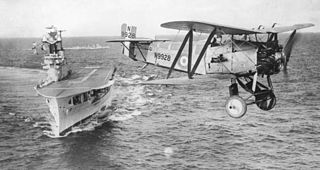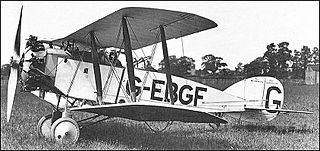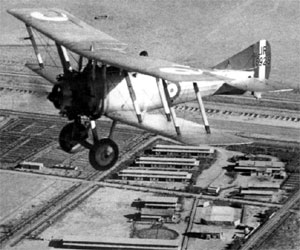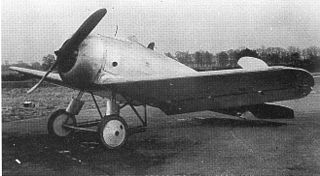Parnall was a British aircraft manufacturer that evolved from a wood-working company before the First World War to a significant designer of military and civil aircraft into the 1940s. It was based in the west of England and was originally known as George Parnall & Co. Ltd.

The Fairey Flycatcher was a British single-seat biplane carrier-borne fighter aircraft made by Fairey Aviation Company which served from 1923 to 1934. It was produced with a conventional undercarriage for carrier use, although this could be exchanged for floats for catapult use aboard capital ships.

The Armstrong Siddeley Jaguar is an aircraft engine developed by Armstrong Siddeley. The Jaguar was a petrol-fuelled air-cooled 14-cylinder two-row radial engine design. The Jaguar III was first used in 1923, followed in 1925 by the Jaguar IV and in 1927 by the Jaguar VI. In 1925 the Jaguar became the first production aero engine incorporating a geared supercharger.
The Fairey Hamble Baby was a British single-seat naval patrol floatplane designed and built by Fairey Aviation for the Royal Naval Air Service

The Fairey Pintail was a British single-engine floatplane fighter of the 1920s. While it was developed by Fairey as a reconnaissance fighter for the Royal Air Force, the only orders placed were for three for the Imperial Japanese Navy.

The Vickers Type 143 or Bolivian Scout was a British single-seat fighter biplane designed and built by Vickers in 1929–1930. Six were built for Bolivia in 1930, which used the survivors in the Chaco War against Paraguay.

The Parnall Panther was a British carrier-based, spotter and reconnaissance aircraft designed and developed by Parnall and Sons in the latter years of the First World War, continuing in service until 1926. A total of 150 Panthers were built by Bristol Aeroplane Company since after the end of the war, Parnall had stopped aircraft manufacture.

The Nightjar was a British carrier-based fighter aircraft of the early 1920s. It was a modification of the earlier Nieuport Nighthawk fighter produced by Gloster after the Nieuport & General company, which designed the Nighthawk, closed down. Twenty-two were converted, serving with the British Royal Air Force from 1922 to 1924.

The Bristol Boarhound was a British army cooperation and liaison aircraft of the 1920s. It was a two-seat biplane with wings of equal span and a steel frame construction with fabric covering.

The Bristol Bloodhound was a British two-seat reconnaissance/fighter aircraft designed and built by the Bristol Aeroplane Company as a possible replacement for the Bristol F.2 Fighter for the Royal Air Force. It was unsuccessful, only four prototypes being built.

The Bristol Type 76 Jupiter Fighter and Type 89 Trainer were derivatives of the British fighter of the First World War, powered by Bristol Jupiter radial engines. While unsuccessful as a fighter, it was used as an advanced trainer aircraft between 1924 and 1933.

The Nieuport Nighthawk was a British fighter aircraft developed by the Nieuport & General Aircraft company for the Royal Air Force towards the end of the First World War. Although ordered into production before the aircraft first flew, it did not enter large scale service with the RAF owing to unreliable engines. Re-engined aircraft did see service in Greece, serving from 1923 to 1938.

The Supermarine Sea King was a British single-seat amphibious biplane fighter designed by Supermarine in 1919. Developed from the Supermarine Baby and the Supermarine Sea Lion I, the Sea King was a single seater biplane powered by a pusher 160 horsepower (120 kW) Beardmore engine. It first flew in early 1920 and was exhibited by Supermarine at the 1920 Olympia Show in London. The company released drawings of the aircraft's design prior to the show; what it exhibited was probably a modified Supermarine Baby.

The Fokker D.XVI was a sesquiplane fighter aircraft developed in the Netherlands in the late 1920s.
The Handley Page HP.14, also designated Handley Page R/200 was a prototype British naval reconnaissance aircraft of World War I, capable of operating from the decks of the Royal Navy's aircraft carriers or as a floatplane. Only three were built, the Parnall Panther being preferred.

The Parnall G.4/31 was a 1930s design from the George Parnall and Company to meet Air Ministry Specification G.4/31 for a "general purpose" aircraft.

The Westland Weasel was a prototype British two-seat fighter/reconnaissance aircraft of the First World War. Designed to replace the Bristol Fighter, the Weasel was a single engined tractor biplane. Four prototypes were built, but no production followed owing to the failure of its original engine, although the prototypes were used as engine test beds for the successful Armstrong Siddeley Jaguar and Bristol Jupiter engines.

The Handley Page Type S, or HPS-1 was a prototype British carrier-based fighter developed for the United States Navy in the early 1920s. A low-wing monoplane, it was unsuccessful, only two being built and flown.

The Fairey Ferret was a 1930s British general-purpose biplane designed and built by the Fairey Aviation Company. It performed well in trials but was not ordered into production.
The Yokosuka E5Y was a single-engine Japanese seaplane used for reconnaissance. The E5Y was also built by Kawanishi as the E5K
















